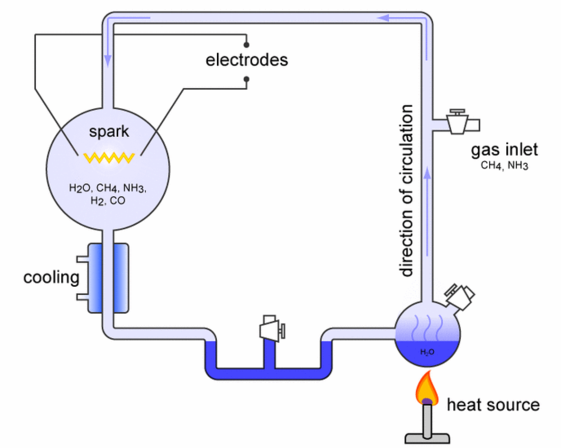 |
 |
 |
 |
 |
 |
 |
 |
|
 |
 |
 |
33 The Miller experiment
|
| Menu | back |
In 1953, biologist and chemist Stanley L. Miller constructed a test apparatus to simulate the development of amino acids under primordial soup conditions. He was successful in synthesizing various simple amino acids by means of a spark discharge in a gas mixture over a number of days. However, his experiment has become insignificant in present molecular biology for a number of reasons. The water in Millers primordial soup prevented the formation of chain molecules. Toxic substances also developed in his primordial soup. The experiment was accomplished under the exclusion of oxygen and otherwise does not coincide with todays knowledge regarding the primordial atmosphere of the Earth.
For some time, Stanley L. Millers experiment was celebrated as a resounding success for evolutional theory. Even today, many school books still contend that life began with lightning acting on a particular primordial atmosphere. At that time, the first basic building blocks of life, the amino acids, supposedly evolved. The Miller experiment allegedly provides proof that such a scenario in natural science (1) is reproducible.
|
 |
|
Setup of the Miller-Urey experiment:
40 years after which he had become famous for his primordial soup experiment Miller distanced himself from the idea that life could develop in a primordial soup. |
However, the primordial soup experiments performed by Stanley Miller and others have become uninteresting, because only fractions of the necessary basic building blocks for life develop under the described primordial soup conditions (2).
Biochemist Klaus Dose came to a sobering conclusion, still valid today, following the Eighth International Conference on The Origin of Life. He had to recognize that a major portion of the reaction products from simulation experiments were no closer to life than the contents of coal tar (3).
In spite of, or perhaps due to, numerous experiments on the origin of life, the insight is increasing that natural chemical processes are not able to initiate life.
Concentration and practical combination of amino acids:
Even if amino acids were formed in a primordial soup, it would be necessary for them to concentrate in a further step and combine spontaneously to form practical molecular chains capable of carrying information. At least 500,000 base pairs are required to produce even the DNA of the simplest bacteria. Cell tissue, cell walls and various mechanisms must be formed simultaneously in order for the cell to be viable from the very beginning.
These 34 | Menu |
back
|
References:
|
| (1) |
Stanley L. Miller, A Production of Amino Acids Under Possible Primitive Earth Conditions, Science 117, 15 May, 1953, pages 528529. |
| (2) |
Paul Lüth, Der Mensch ist kein Zufall, DVA, Stuttgart, 1981, pages 4664. |
| (3) |
Bruno Vollmert, Das Molekül und das Leben, Rowohlt, 1985, pages 3945. | |
| |
Comment this Site!
|
 |
 |
 |
 |
|

